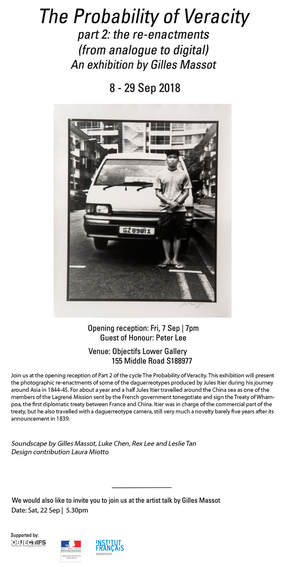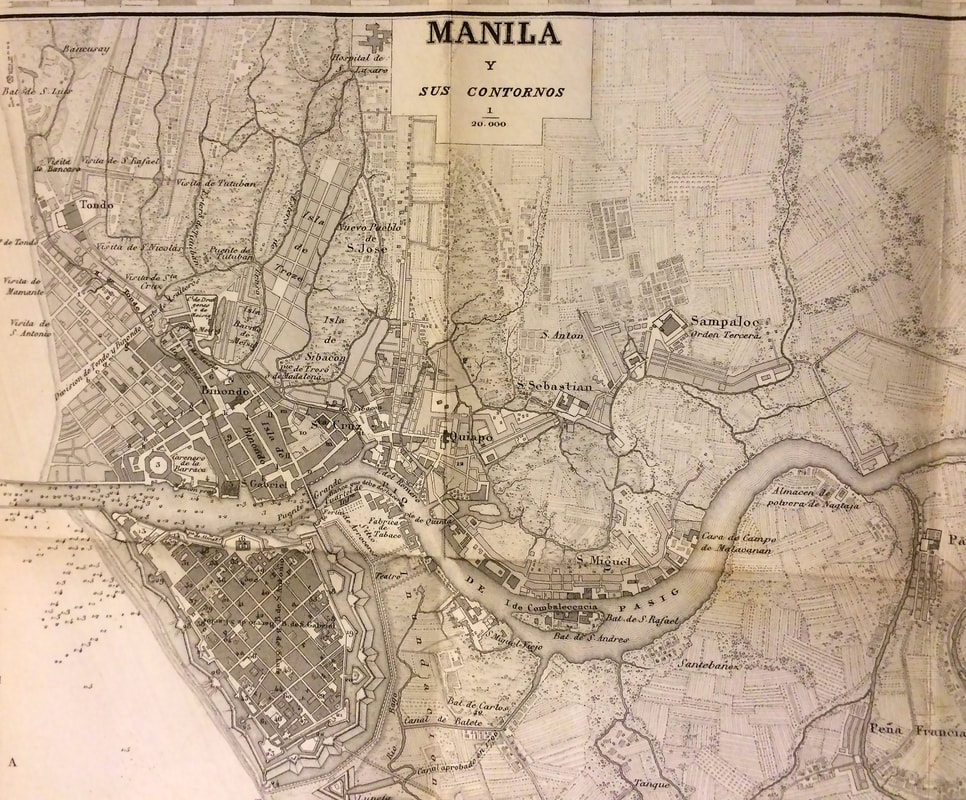Hosted by the cool and happening center for photography and cinema Objectifs, Part 2 of The Probability of Veracity presented the photographic re-enactments of daguerreotypes produced by Jules Itier during his Asian journey in 1844-45. For a year and a half Itier travelled around the China sea as one of the members of the Lagrené Mission sent by the French government to negotiate and sign the Treaty of Whampoa, the first diplomatic treaty between France and China. Itier was in charge of the commercial part of the treaty, but he also travelled with a daguerreotype camera, still very much a novelty five years after its announcement in 1839. With the help of a grant from LASALLE College of the Arts, I could complete a research started in 2011 and completed in 2015 with the publication of the article Jules Itier and the Lagrené Mission in the prestigious journal History of Photography. In this article, I could established important points concerning the early phase of photography history in Asia and identify Itier’s daguerreotype of the Tian Hock Keng temple in Singapore shot on the 6 July 1844 as the oldest extant dated photograph of the whole Asian continent.
The Sound ScapeThe sound scape developed in collaboration with Luke Chen, Rex Lee and Leslie Tan was an important part of the exhibition. For a full sensorial experience of this page it is therefore recommended to play the sound tracks below while browsing.
To play all six tracks in one go click on the photograph above and keep the page open while browsing.
To play each track individually click on the respective maps below.
|
Exhibition Invitation and Wall TextLower Gallery and Theory Lounge Installation
|
|
................Theory.....L o u n g e................
The Theory Lounge adjacent to the gallery presents the latest developments of my research on the theory of photography through the association of a scholarly paper in three parts, each written by a different alter egos and three art works resulting from the research on Jules Itier.
22 . A State of Superimposition associated to From Chiaroscuro to the collapse of the wave function: understanding photography as energy by the french historian Gaston Gabriel Marceau.
(silkscreen on acrylic mirror, wood, LED light) This sculptural piece materialises the dual nature of the daguerreotype which makes the historian Gaston Gabriel Marceau parallel this form of photographic image to the understanding of the photon that resulted from the double slit experiment at the on-set of Quantum Mechanics.
The two videos below are best viewed switched on together to let their respective 23mn durations run simultaneously.
|
|
23 . Live from the Lighthouse associated to White Space Theory: towards a physics of mnemonics by the Chinese physicist Pr. Ma.
single channel video - 23 mn |
|
This video documenting the re-enactment of the Danang Bay daguerreotype was shot from the top of the lighthouse at the entrance of the bay. The original meditative flavour was emphasised trough an editing to express the photographic mystery at the heart of Pr Ma's White Space Theory. It is enhanced by musical improvisations duplicating the analogue to digital evolution of the sound scape, from cello to theremin to electronic.
24 . Papa papa, what have you done to us! associated to Open call to open-minded scientists by the Singaporean Malais artist Gila Masok.
single channel video - 23 mn |
|
This video documented the re-enactment of one of the A-ma Temple daguerreotype in Macao. The lively irreverent intervention of the little boy, who clearly enjoyed tremendously kicking his ball into the camera tripod, aptly mirrored the urgency and tong-in-cheek tone of Gila Masok's open call for open minded scientists: "when will you stop seeing photography as a maid and take her as a mistress?"
|
Printing process . . . . . . . . . . .. . . . . . . . . . from analogue to digitalThe darkroom technique used for the twenty one prints making up this exhibition is a complex experimental process chosen for its conceptual significance and uncanny aesthetic. it was first explored in the context of the 2009 edition of the Singapore Month of Photography to be used as an opening event of an exhibition by Alain Fleisher, to be held in the Singapore Art Museum.
One of Fleisher's most significant works is a form of photographic performance for which he shoots a short 16mn black and white movie that must include a number of scenes in which some actors stay still for a few minutes. For the performance, the assistance is gathered into a large hall turned into a darkroom and the movie projected as negative on a giant piece of photographic paper, the "screen". The latent image is then developed with mops dipped into buckets of standard black and white developer, after which the print is fixed and washed in a similar manner, still in front of the audience who witness the full process of the image's apparition, all the way to its final revelation when light are switched on. The final print is thus a compression of the 10 minutes movie in which only actors who stood still long enough leave their image on the paper. Fleisher's photographic play with time and space, at once pictorial and conceptual, was everything that I liked and I eagerly took up the offer by the festival's producer to gather a team of LASALLE students to become his assistants. Alain was to visit Singapore four month prior the event to train the team. One point in the technical requirements I was given to prepare his visit quickly raised concerns. Finding a 16mm movie projector wasn't too difficult. What turned out to be impossible was to process a black and white 16mm movie locally, or even regionally. The near obsolete technology required sending the movie overseas, and it would take weeks for it to come back. We had no other solution than shoot a video, project it with the digital light of a video projector, and deal through trial and errors with the uncertainties this switch implied. And indeed the first day of trial saw us faced by a truly puzzling mystery; one of those photographic mysteries so puzzling at first that they seem to emerge out of a subliminal hidden dimension but which dedicated practitioners never fail to resolve through systematic analytic patience. Alain's previous mastery of the technique included the use of grey density filters to control the exposure and adjust the light intensity to fit the length of the movie. That day however it turned out that no matter how many filters were used the test print invariably turned black. Even worst, no matter how short the exposure could be, the result would be equally inadequate. The disheartening conclusion after two hours of essay was that the numerous filters made the projection too dark to see anything of the image on the wall, even if the exposure was down to below thirty second, when in fact the movie was meant to run for over ten minutes. No matter what the settings were, our test print on the wall would turned totally black, hopelessly, utterly black. Clearly the digital light acted in a totally unpredictable manner on the analogue paper, and none of us could make sense of it. Even Alain, for all his experience, had no solution to a problem that was indeed brand new to all of us: the bringing together of traditional analogue dark room technique and electronic equipment. Eventually, the answer came from Lim Sheng En, a last minute addition to the team of students who came in late, just as we were about to sink into total despair. And it was all very simple once approached with the right understanding: what we perceive as black in a digital light projection is not equivalent to the absence of light of an analogue one. Digital black is a colour, it is STILL light and the grey filters had clearly no impact on it. We had to replace them with chromatic amber filters and cut down the RGB channels of the projector to just red, by right the colour to which the paper would be least sensitive to. And it worked. An image appeared, and it was beautiful because it combined the organic tactile quality of the silver print to the electronic grid of virtual pixels. The technic brought photographic past and future together as one. Another student, Nah Yong En took the whole process in hand and worked tirelessly to master its different aspects all the way to the resounding success of the performance night. I found the pictorial results really interesting and so for the next few years, the technique remained a project of experimental dark room technique in the syllabus of my photo course. In fact I ran it until the leftover of the paper roll used for Alain's sensitive screen project lasted. But the technique remained highly unpredictable, almost mercurial in its results. At times it worked beautifully, at others the print tended to be stubbornly overexposed, as in our first experiments, although we used the right filters and settings. I would eventually understand the mystery behind this persistent observation a few years later, in the last round of printing done for the Probability of Veracity - part 2 series. The idea to re-enact Itier's shots was a key artistic element of my research proposal with LASALLE. And right from the start I could see how this technique that bridged the gap between past and future would fit the artistic journey in his footstep. I decided to further enhanced its theoretical content by using a pinhole camera for shooting in order to take the process all the way back to its very origin: to the phenomena from which photography was born. From pinhole to digital light, these re-enactments would be a pictorial experiment befitting my contemporary investigation of the first existing images of Asia. The resulting body of work was a labour of love, both in its its complexity and by the amount work it required for its completion. For each of the prints, the steps were as follow:
|




























